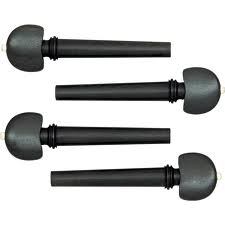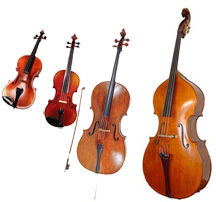String Music Terms
Welcome to our Glossary of String Music Terms where you can get the basic knowledge of terms used in the string music profession.
These string music terms are the names of instruments:
- Violin: The violin or “fiddle” is a string instrument which is played with a bow. It is the smallest member of the string family of orchestra instruments. The violin has 4 strings. The names of the strings are E, A, D and G. The violin is very similar to the viola, but the violin has plays higher pitches. The violin comes in fractional sizes 1/64 to 3/4 and of course the 4/4 size violin.
- Viola: The viola is a little bit bigger then the violin. The viola string instrument is measured by inches no fractions like the violin. The viola is available in 14″ – 17.5″ but if you need a smaller viola, it is possible to put viola strings on a violin. The viola has four strings which are A, D, G and C.
- Cello: The cello is much larger then the violin or viola. It is played sitting down but is still a bowed string instrument. The strings on the cello are A, D, G and C but sound one octave lower then the Viola. Cellos are available is 1/10 – 4/4 sizes.
- Bass: The Bass is the largest instrument in the string family. It is played standing or sitting on a tall stool. The bass is also commonly called the string bass, double bass, stand up bass or acoustic bass. The strings on the bass are G, D, A and E. Basses are available in 1/8 – 4/4 sizes.
These String Music Terms are parts and accessories for string instruments:
- Bow: A violin bow, viola bow, cello bow or bass bow is made of wood and have horse hairs which pull the strings to make a sound. There is rosin that is applied to the horse hairs to make them sticky enough to grab the string.
- Rosin: Rosin is made of tree sap which has been cooked into a solid so that it may be rubbed on the hairs of a bow.
- End Pin: The Cello End Pin or Bass End Pin is a metal rod that comes out of the bottom of a cello or bass to support the instrument. It rests on the floor allowing the cello or bass to be suspended and easier to play. When the Cello or Bass is put away the end pin conveniently slides into the body of the instrument for storage. Violins and Violas do not have end pins.
- Fittings: The fittings of a string instrument include the Pegs, Bridge, Tail Piece, Chin Rest (on violins and violas), or End Pin (on cellos and basses). A string instrument that comes “set up” with have all of these parts included.
- Chin Rest: A Violin Chin Rest or Viol Chin Rest is an accessory that usually comes as part of the fittings of the violin or violin. The chin rest helps the violinist hold the violin in place on the shoulder by using just the head and not the hands. The name chin rest is actually a misnomer because the JAW is the body part that goes in the chin rest not the CHIN. WE should call it the JAW REST. 😉
- Shoulder Rest: A violin or viola shoulder rest is used to help support the violin or viola on the musicians shoulder. The added support helps in holding the violin or viola without the hands. Cellists do not need shoulder rests. There are many different shoulder rest options available.
- Rock Stop: A Cello Rock Stop or Bass Rock Stop is a type of end pin anchor that goes on the floor to keep the end pin from slipping. Violinists and Violists do not need Rock stops. There are many different rock stop options available.
These String Music Terms are techniques that string players use:
- Vibrato: Vibrato is an expression that string players (like vocalists) can add to music. The pitch is fluctuated rapidly but subtly. Vibrato can be used to add warmth and character to all types of music.
- Accent: An accent in sheet music looks like this: > or this: v and means to emphasized a note with a little force. An accented note will have a “consonant” sound at the beginning of it “k” or “t”
- Pizz: Pizz. is an abreviation for Pizzicato (not pizza;-) and means to pluck the string. A + sign means LEFT HAND Pizzicato.
- Arco: Arco means with the bow and often appears in music after pizz. (pizzicato or plucked) passages of music.
These String Music Terms can be found in sheet music and are related to tempo (or speed):
- A tempo: A tempo (or in tempo) means to return to the original tempo or speed from the beginning. It usually shows up in music after a change in temp has occurred.
- Accelerando – Accelerando can be abbreviated Accel. and means to Accelerate or speed up gradually.
- Presto – Very Fast
- Allegro: An Allegro Tempo is Fast and Happy. Allegro is not as fast as Presto. Sometimes a movement of a piece of music will be called “Allegro”
- Andante: Andante literally means “walking tempo” and would be considered a moderately slow tempo.
- Allegretto: Allegretto is moderately fast. An Allegretto tempo would be slower than allegro, but faster than andante.
- Vivace: A Vivace Tempo is lively and brisk. Vivace would be slightly faster than allegro.
- Adagio: A slow, leisurely tempo, often considered to be slower than andante, but not quite as slow as largo. Sometimes a movement of a piece of music will be called “Adagio”
- Moderato Moderato means to play at a moderate tempo or speed. This term sometimes modifies others such as Allegro moderato, which means moderately fast.
- Largo: A broad, slow tempo that is dignified and stately in style. Largo is the slowest of tempo markings.
These String Music Terms are Dynamics (how loud and soft the music is supposed to be played)
- Pianissimo: Pianissimo is written pp and means very soft.
- Piano: Piano is written p and means soft.
- Forte: Forte is written f means “loud”
- Fortissimo: Fortissimo is written ff and means very loud
- Fortississimo: Fortississimo is written fff and means “very, very loud”
- Crescendo: A Crescendo in sheet music looks can be abbreviated “cresc.” This string music terms mean to get louder little by little.
- Diminuendo: A Diminuendo in sheet music can be abbreviated “dim.” It can also be called a decrescendo (abbreviated decresc. or decr.) This string music terms mean to get softer little by little. This is the opposite of a Crescendo.
These String Music Terms have to do with the “road map” or where you go in the music:
- Repeat Signs: A double bar with two dots is a repeat marking, and indicates the music in between the repeat signs should be repeated. If there is only one repeat sign with the dots facing to the left, go back to the beginning and play the entire section of music again.
- Da Capo: A Da Capo is written “D.C.” and means “back to the head” or to repeat all the way to the beginning of the song.
- Coda: Coda means the “tail” or ending of a piece of music. Codas are often written as a “tag” ending to the piece.
- Dal Segno: A Dal Segno is written “D.S.” and means “back to the sign” or to repeat to the sign which look like this:
- D.C. al Coda: This means to go “back to the head” or to repeat all the way to the beginning of the song but then to jump to the “Coda” when you reach the coda sign which looks like this:
- D.C. al Fine: This means to go “back to the head” or to repeat all the way to the beginning of the song but then end at the “Fine” marking.
- Fine: Fine is pronounced “feenae” and means END
These String Music Terms have to do with the way the music is played:
- Legato: Legato indicates the notes should be smoothly connected, played either in one or several bows. Slurs are often used to indicate legato.
- Marcato: An Italian term which means marked or accentuated.
- Martelé: Martelé means hammered. Each note is percussive, and commences with a sharp accent or “pinch” at the beginning of the note, followed by a quick release. Martelé may be notated in more than one way: with dots, hammer heads or accents.
- Muted A direction for the musician to play with a mute. For string players, mutes are small clamps of wood, metal, rubber, leather or plastic, which fit onto the bridge and result in a softer, muted sound with a veiled quality.
- Slur A slur is a curved line grouping notes together, and means the notes included in the slur should be played in the same bow.
- Sonata The word sonata comes from the Italian word sonore, meaning “to be played” (as opposed to cantata, a vocal work which means “to be sung”). A sonata is an instrumental form of music, and describes a multi-movement work for an instrument, often with accompaniment. The term has had varied meanings during different music eras, and during the Baroque period, the trio sonata was one of the most popular forms of sonata (often for two violins and continuo). During the Classical period, sonata came to mean a multi-movement work for a solo instrument with piano accompaniment, or piano alone.
- Spiccato Spiccato is an off-the-string, controlled bouncing bow stroke which produces a crisp sound and very short notes. It is the slowest of the bouncing strokes. Dots above or under the notes may be used to indicate spiccato.
- Staccato Staccato indicates the bow should remain on the string to play shortened and detached notes, distinctly separate from successive notes. Staccato is sometimes used with slurs (slurred staccato) for a series of short, stopped notes played in the same up or down bow (many violinists perform slurred staccato as a series of slurred martelé strokes).
- String Quartet A string quartet is a composition for four stringed instruments: two violins, a viola and a cello. String quartet music generally is composed in a multi-movement form. The term string quartet is also used to describe a performance group comprised of four stringed instruments.
- Symphony A symphony is an extended composition for orchestra and is often comprised of three to five movements.
- Tie When a slur is placed between two notes with the same pitch, this is called a “tie” and the two notes are played in one bow for the duration of both notes.
- Tremolo Tremolo means rapidly repeating a single note or chord (see bowing chart for more details).
- Trill A trill ornaments a note, and is a rapid alternation between two pitches, usually a major or minor second above the note. The letters tr and a wavy symbol are used as trill markings. Accidentals are often used to indicate whether the trill is a major or minor trill.
- Up bow The sign for up-bow is and indicates an upward stroke of the bow from the point (or tip) to the frog (or nut).
- Whole Bow Initials are sometimes used in music to indicate what part of the bow should be used:
WB = Whole Bow; LH = Lower Half; UH = Upper Half; MB = Middle of the Bow.
These String Music Terms are Types of Music:
- Waltz: A type of dance in a 3/4 time signature.
- Chamber music: Chamber music is used to describe instrumental music performed by a small ensemble such as a quartet, trio or chamber orchestra.
- Concerto: An instrumental composition for solo a instrument with three movements. The sequence +of the movements in a concerto generally is usually fast-slow-fast.
- Theme & Variations: A composition with a theme and variations of that theme.
- Opera: A musical form of drama, originating in Italy, set to music. In an opera, most or all of the text is sung, using musical forms such as arias, songs, recitatives, duets, and choruses, with instrumental accompaniment. A few of the various subcategories of opera include heroic or grand opera, comedy opera and comic opera.
- Symphony A symphony is an extended composition for orchestra and is often comprised of three to five movements.



Ready to pursue
your dream?
Schedule just 1 lesson, a few lessons or recurring lessons.
Join Online Violin Group Class.


